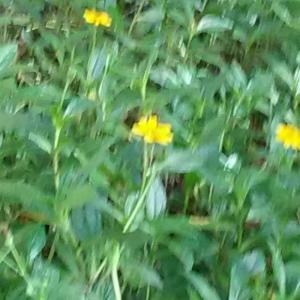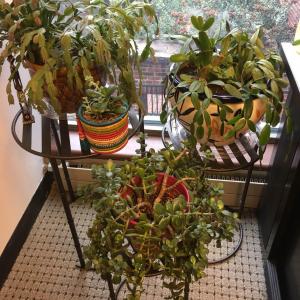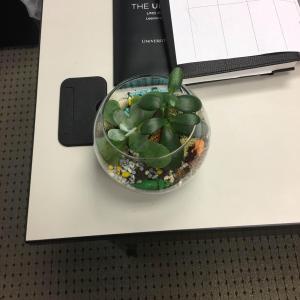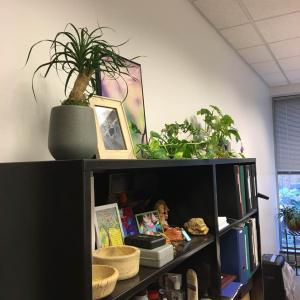求助
Deanna Dubbs
2017年10月14日

I came home yesterday to him lookig like this...I check on my plants everyday and he was fine the day before. I dont’t think I can save him. Any advice on how to prevent or fix this is appreciated.
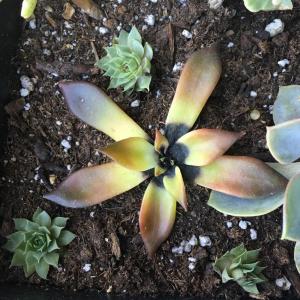

1
0
Deanna Dubbs:@Ueca got it. I’m going to take them all out and redo the soil tonight ><
Ueca:I recommend you remove the blackened plant from the others. While the chance is very low, surrounding plants may get infected.
Deanna Dubbs:@Ueca it’s so weird because I watered like two weeks ago...I think I need to redo the soil
Ueca:It's generally caused by watering too shallow, too often. These prefer the water going deep and then staying dry for a few weeks.
成长记
Deanna Dubbs
2017年10月14日

I came home yesterday to him lookig like this...I check on my plants everyday and he was fine the day before. I dont’t think I can save him. Any advice on how to prevent or fix this is appr eciated.


0
0
成长记
Becka
2017年10月11日

I now added "Anyone know what any of these plants are called?? 😊" in my "garden"


0
0
Ueca:Left side is Rhipsalis. Don't know the species because the glass is blurry.
文章
Dummer. ゛☀
2017年10月08日

Cannas are lush tropical plants with huge leaves and vibrant blossoms on tall stalks. Many varieties have multicolored and patterned leaves, making them a season-long focal point.
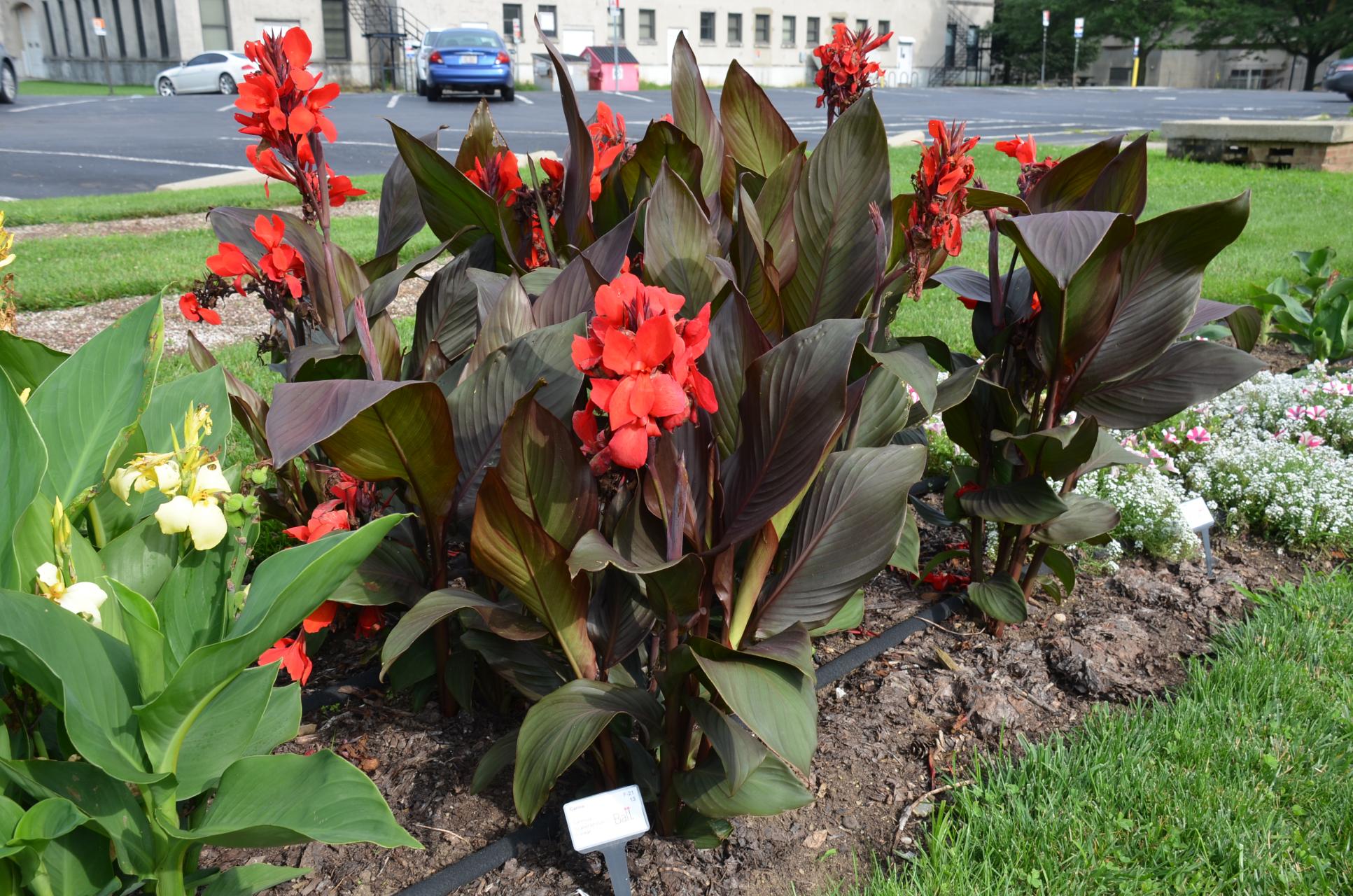
Choosing a site to grow cannas
Select a site with full sun and moist soil. Tall varieties should be sheltered from strong winds.
Special features of cannas
Unusual foliage

Planting Instructions
Plant canna rhizomes in spring after all danger of frost has passed and the soil has warmed. Prepare the garden bed by using a garden fork or tiller to loosen the soil to a depth of 12 to 15 inches, then mix in a 2- to 4-inch layer of compost. Dig a hole 4 to 6 inches deep. Set the rhizome horizontally in the hole, cover it with soil, and press firmly. Space rhizomes 1 to 4 feet apart, depending on the variety. Water thoroughly. In regions with short summers, start rhizomes indoors by potting up and placing them in a warm, sunny location.
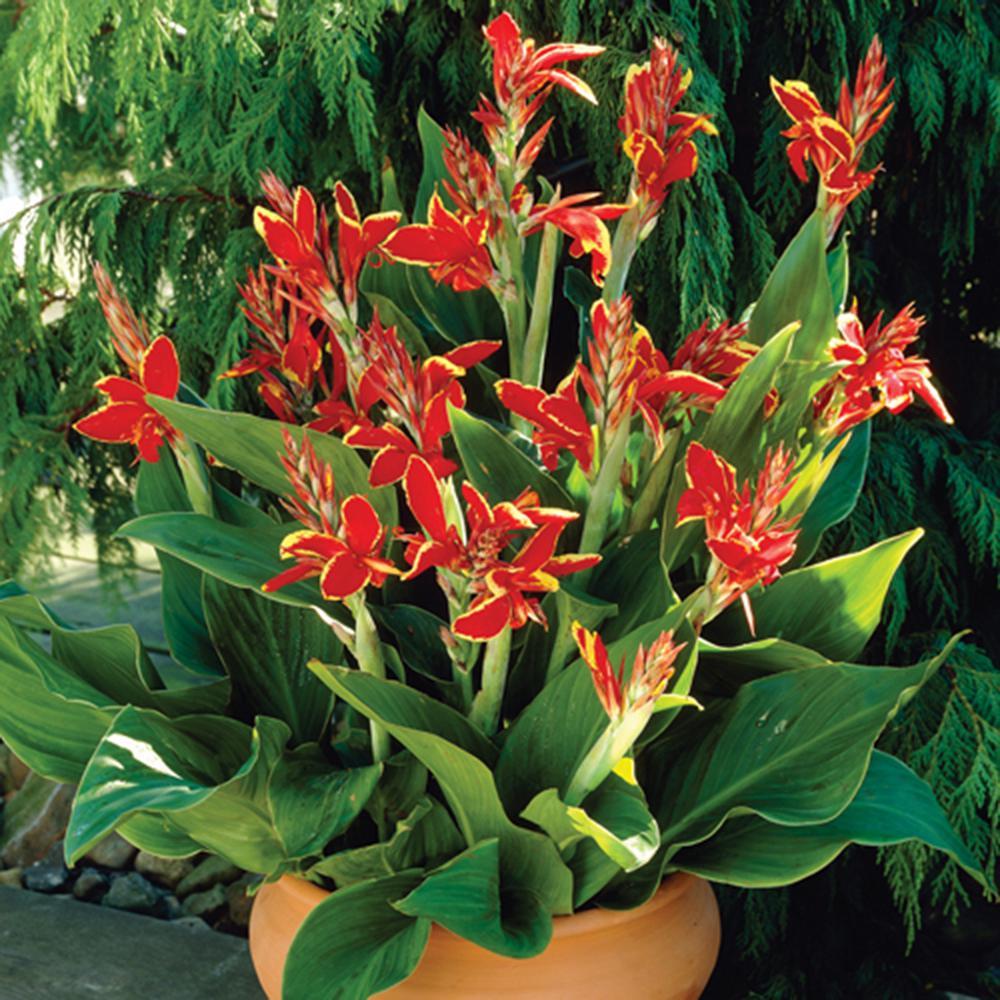
Ongoing Care
Apply a 2- to 4-inch layer of mulch around cannas to retain moisture and control weeds. Cannas prefer consistently moist soil, so water plants during the summer if rainfall is less than 1 inch per week, and water container-grown plants frequently to keep soil moist. Stake tall varieties to keep them upright. Remove flowers as they fade. In autumn, after frost kills the foliage, cut plants back to 6 inches tall. Carefully lift each clump of rhizomes and put them in a plastic-lined box filled with perlite or peat moss, spacing them so that none are touching. Store boxes off the floor in a dry area at 45 to 55 degrees F. Replant in the spring.

Choosing a site to grow cannas
Select a site with full sun and moist soil. Tall varieties should be sheltered from strong winds.
Special features of cannas
Unusual foliage

Planting Instructions
Plant canna rhizomes in spring after all danger of frost has passed and the soil has warmed. Prepare the garden bed by using a garden fork or tiller to loosen the soil to a depth of 12 to 15 inches, then mix in a 2- to 4-inch layer of compost. Dig a hole 4 to 6 inches deep. Set the rhizome horizontally in the hole, cover it with soil, and press firmly. Space rhizomes 1 to 4 feet apart, depending on the variety. Water thoroughly. In regions with short summers, start rhizomes indoors by potting up and placing them in a warm, sunny location.

Ongoing Care
Apply a 2- to 4-inch layer of mulch around cannas to retain moisture and control weeds. Cannas prefer consistently moist soil, so water plants during the summer if rainfall is less than 1 inch per week, and water container-grown plants frequently to keep soil moist. Stake tall varieties to keep them upright. Remove flowers as they fade. In autumn, after frost kills the foliage, cut plants back to 6 inches tall. Carefully lift each clump of rhizomes and put them in a plastic-lined box filled with perlite or peat moss, spacing them so that none are touching. Store boxes off the floor in a dry area at 45 to 55 degrees F. Replant in the spring.
2
2
文章
Dummer. ゛☀
2017年10月02日

People have been growing Aloe vera for literally thousands of years. It is one of the most widely used medicinal plants on the planet. If you are wondering, “How can I grow an aloe plant?” We are here to tell you that taking care of an Aloe Vera plant in your home is easy.
Keep reading to learn more about how to grow and care for an Aloe Vera plant.

Growing Conditions
The first step in Aloe Vera care is to realize that this plant is a succulent. Like cacti, succulents do best in dry conditions. When growing Aloe Vera plants, plant them in a cactus potting soil mix or a regular potting soil that has been amended with additional perlite or building sand. Also, make sure that the pot has plenty of drainage holes. It cannot tolerate standing water.
One important thing in the care of Aloe Vera houseplants is that they have proper light. They need bright light, so they do best in south- or west-facing windows.

General Care
Another important part of how to grow an Aloe Vera is to water the plant properly. The soil should be allowed to go completely dry before being watered. When the plant is watered, the soil should be thoroughly drenched, but the water should be allowed to drain freely from the soil. The most common reason an Aloe Vera dies is that the owners water too often or do not allow the water to drain. Do not make this mistake when taking care of Aloe houseplants.
You can fertilize your Aloe Vera, but Aloes do not need to be fertilized. If you decide to add fertilizing to part of your Aloe Vera plant care routine, plants should be fertilized once a year in the spring. You can use a phosphorus-heavy water-based fertilizer at half strength.
Growing Aloe Vera houseplants is not only easy but can also provide your family with a plant that can help treat minor burns and rashes. Now that you know a little more about how to care for an Aloe Vera plant, you need never be without this lovely and helpful plant.
Keep reading to learn more about how to grow and care for an Aloe Vera plant.

Growing Conditions
The first step in Aloe Vera care is to realize that this plant is a succulent. Like cacti, succulents do best in dry conditions. When growing Aloe Vera plants, plant them in a cactus potting soil mix or a regular potting soil that has been amended with additional perlite or building sand. Also, make sure that the pot has plenty of drainage holes. It cannot tolerate standing water.
One important thing in the care of Aloe Vera houseplants is that they have proper light. They need bright light, so they do best in south- or west-facing windows.

General Care
Another important part of how to grow an Aloe Vera is to water the plant properly. The soil should be allowed to go completely dry before being watered. When the plant is watered, the soil should be thoroughly drenched, but the water should be allowed to drain freely from the soil. The most common reason an Aloe Vera dies is that the owners water too often or do not allow the water to drain. Do not make this mistake when taking care of Aloe houseplants.
You can fertilize your Aloe Vera, but Aloes do not need to be fertilized. If you decide to add fertilizing to part of your Aloe Vera plant care routine, plants should be fertilized once a year in the spring. You can use a phosphorus-heavy water-based fertilizer at half strength.
Growing Aloe Vera houseplants is not only easy but can also provide your family with a plant that can help treat minor burns and rashes. Now that you know a little more about how to care for an Aloe Vera plant, you need never be without this lovely and helpful plant.
2
1
文章
Dummer. ゛☀
2017年10月02日

Herbs are plants, even those we might consider weeds, that have useful purposes. They may be used for flavorings, fragrances, pesticides, medicines or dyes. Succulent plants are generally recognized has having fleshy parts, such as leaves, stems or trunks; this fleshiness is a result of water storage in the plant’s tissues. Although there aren’t many plants that are both succulent and herbal, a few genera possess both qualities.

Purslane
Purslane (Portulaca oleracea), hardy in U.S. Department of Agriculture plant hardiness zones 3 through 10, is one of those plants that are considered weedy by most gardeners. It has small, green leaves on fleshy red stems and stays low to the ground. It has a slightly sour and lemony flavor and is eaten in a variety of ways. Most people just eat it raw in salads, but it can be sauteed and seasoned in the same way one would cook spinach, and even pickled with garlic and peppercorns. It is also known as Little Hogweed.

Aloe
Aloe may likely be one of the more popular succulent herbs. Aloes form a rosette of thick, fleshy leaves with a slightly frosty blue-green color. Aloe vera is probably the best-known species. It is most often used as a houseplant but can be grown outside in USDA zones 10 through 11. Because it is not frost hardy, some people in zone 9 choose to grow Aloe ferox, which has much the same appearance but is slightly hardier. These Aloes are often used medicinally. The jelly-like substance that exudes from the cut leaves is often applied to minor wounds or burns.

Indian Borage and Cuban Oregano
Indian Borage (Plectranthus aromaticus or Coleus aromaticus) is also called the All Purpose Herb. The leaves are strongly oregano-flavored but not particularly palatable for salads because of their fuzzy leaves. The leaves are commonly used to flavor meats; however, there are also some traditional medicinal uses as well. Cuban Oregano (Plectranthus amboinicus, also called French or Mexican Oregano) also has similar culinary and medicinal uses and has a similar flavor. There is a pretty variegated variety (Plectranthus amboinicus ‘Variegata’) that has a thin cream edge, making it an attractive garden plant. Both of these herb species are hardy in USDA zones 10 through 11 but are grown as annuals elsewhere.

Other Succulent Herbs
The herb Jewels of Opar (Talinum paniculatum) forms a mound of glossy green leaves and clouds of small pink flowers on wiry stems. The foliage is used medicinally and the tangy leaves are eaten fresh or sauteed. The cultivar Talinum paniculatum ‘Limon’ bears chartreuse leaves, and Talinum paniculatum ‘Variegatum’ has creamy white variegation. All are hardy in USDA zones 10 through 11. Samphire, or Sea Fennel (Crithmum maritimum), hardy in USDA zones 7 through 11, has feathery blue-green leaves and pale yellow flower clusters. Leaves are eaten fresh or pickled, and they have traditional medicinal uses as well.

Purslane
Purslane (Portulaca oleracea), hardy in U.S. Department of Agriculture plant hardiness zones 3 through 10, is one of those plants that are considered weedy by most gardeners. It has small, green leaves on fleshy red stems and stays low to the ground. It has a slightly sour and lemony flavor and is eaten in a variety of ways. Most people just eat it raw in salads, but it can be sauteed and seasoned in the same way one would cook spinach, and even pickled with garlic and peppercorns. It is also known as Little Hogweed.

Aloe
Aloe may likely be one of the more popular succulent herbs. Aloes form a rosette of thick, fleshy leaves with a slightly frosty blue-green color. Aloe vera is probably the best-known species. It is most often used as a houseplant but can be grown outside in USDA zones 10 through 11. Because it is not frost hardy, some people in zone 9 choose to grow Aloe ferox, which has much the same appearance but is slightly hardier. These Aloes are often used medicinally. The jelly-like substance that exudes from the cut leaves is often applied to minor wounds or burns.

Indian Borage and Cuban Oregano
Indian Borage (Plectranthus aromaticus or Coleus aromaticus) is also called the All Purpose Herb. The leaves are strongly oregano-flavored but not particularly palatable for salads because of their fuzzy leaves. The leaves are commonly used to flavor meats; however, there are also some traditional medicinal uses as well. Cuban Oregano (Plectranthus amboinicus, also called French or Mexican Oregano) also has similar culinary and medicinal uses and has a similar flavor. There is a pretty variegated variety (Plectranthus amboinicus ‘Variegata’) that has a thin cream edge, making it an attractive garden plant. Both of these herb species are hardy in USDA zones 10 through 11 but are grown as annuals elsewhere.

Other Succulent Herbs
The herb Jewels of Opar (Talinum paniculatum) forms a mound of glossy green leaves and clouds of small pink flowers on wiry stems. The foliage is used medicinally and the tangy leaves are eaten fresh or sauteed. The cultivar Talinum paniculatum ‘Limon’ bears chartreuse leaves, and Talinum paniculatum ‘Variegatum’ has creamy white variegation. All are hardy in USDA zones 10 through 11. Samphire, or Sea Fennel (Crithmum maritimum), hardy in USDA zones 7 through 11, has feathery blue-green leaves and pale yellow flower clusters. Leaves are eaten fresh or pickled, and they have traditional medicinal uses as well.
5
4
文章
Dummer. ゛☀
2017年10月02日

Scientific Name
Conophytum wettsteinii (Berger) N.E.Br.
Common Names
Cone Plants, Dumplings, Button Plants
Synonyms
Mesembryanthemum wettsteinii (basionym), Conophytum wettsteinii var. wettsteinii, Conophytum brevipes, Conophytum circumpunctatum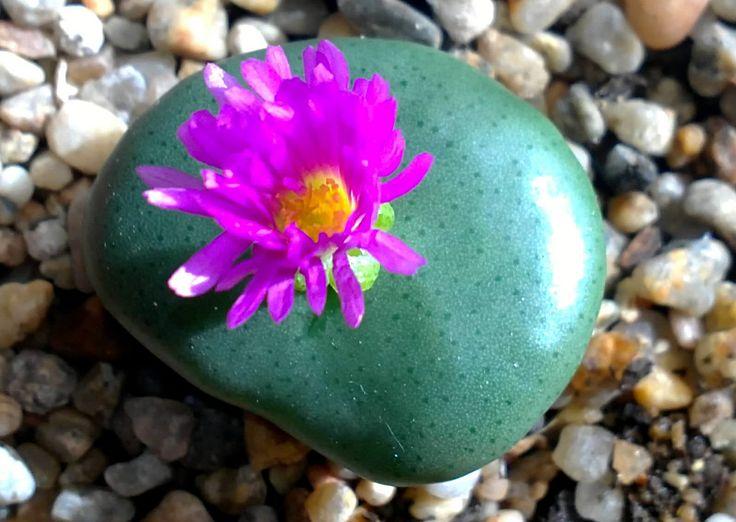
Scientific Classification
Family: Aizoaceae
Subfamily: Ruschioideae
Tribe: Ruschieae
Genus: Conophytum
Description
Conophytum wettsteinii has a broad top (up to 1 inch/2.5 cm wide) and narrowed base. Individual plants seem circular from above, with fissures up to 0.16 inch (4 mm) long. The plant has a green to blue-green color with a spotted, smooth epidermis which may appear glossy. It flowers only in autumn, with scentless flowers opening during the day. Flowers are short and wide, ranging in color from magenta to pale pink or rarely white.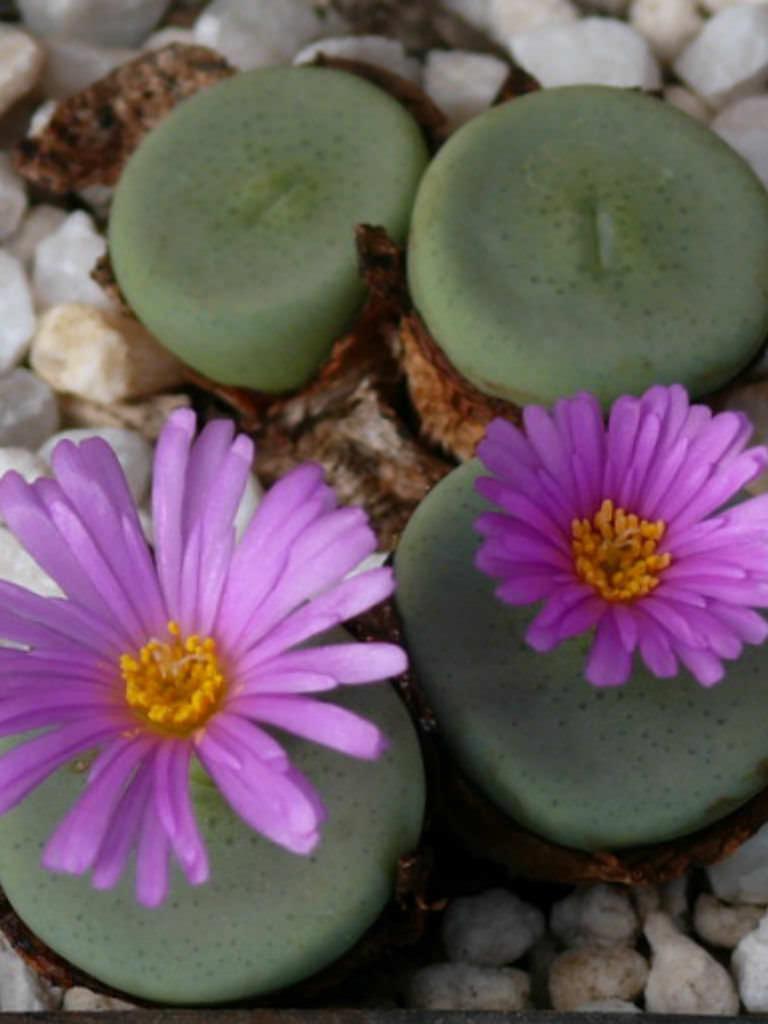
How to Grow and Care
Conophytums are usually grown in dish gardens where they spread slowly but make good ornamental plants for window gardening. They also do well in rockeries where they can be grown in crevices.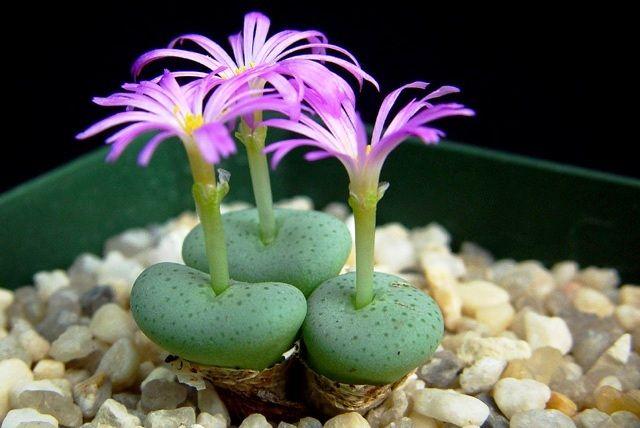
The Conophytum vegetate during the winter season. They must then be kept dry during hot, gradually wet upon autumn arrival: the moisture stimulate the release of new root hairs and the plant will grow for the entire winter season, foliar issuing new pairs from inside the existing ones. Flowering usually occurs in autumn and the color of the flowers is extremely variable from species to species.
Conophytum wettsteinii (Berger) N.E.Br.
Common Names
Cone Plants, Dumplings, Button Plants
Synonyms
Mesembryanthemum wettsteinii (basionym), Conophytum wettsteinii var. wettsteinii, Conophytum brevipes, Conophytum circumpunctatum

Scientific Classification
Family: Aizoaceae
Subfamily: Ruschioideae
Tribe: Ruschieae
Genus: Conophytum

Description
Conophytum wettsteinii has a broad top (up to 1 inch/2.5 cm wide) and narrowed base. Individual plants seem circular from above, with fissures up to 0.16 inch (4 mm) long. The plant has a green to blue-green color with a spotted, smooth epidermis which may appear glossy. It flowers only in autumn, with scentless flowers opening during the day. Flowers are short and wide, ranging in color from magenta to pale pink or rarely white.

How to Grow and Care
Conophytums are usually grown in dish gardens where they spread slowly but make good ornamental plants for window gardening. They also do well in rockeries where they can be grown in crevices.

The Conophytum vegetate during the winter season. They must then be kept dry during hot, gradually wet upon autumn arrival: the moisture stimulate the release of new root hairs and the plant will grow for the entire winter season, foliar issuing new pairs from inside the existing ones. Flowering usually occurs in autumn and the color of the flowers is extremely variable from species to species.
2
1
文章
Dummer. ゛☀
2017年10月02日

Scientific Name
Conophytum calculus (A. Berger) N. E. Br.
Common Names
Marble Buttons, Cone Plants, Dumplings, Button Plants, Living Pebbles
Synonyms
Mesembryanthemum calculus (basionym), Conophytum calculus var. calculus, Conophytum komkansicum
Scientific Classification
Family: Aizoaceae
Subfamily: Ruschioideae
Tribe: Ruschieae
Genus: Conophytum
Description
Conophytum calculus is a small, but very tough, low growing, stemless succulent with individual rounded “leaves” (fused together into one body) that multiply with age and cluster together to form a dome-shaped cushion. The spherically-shaped leaf bodies are completely smooth and hairless, characteristically opaque (non-transparent and non-glossy) and have a chalky-green to pale yellowish green color. The leaf bodies are always without any spot or detail and up to 1.2 inches (3 cm) in diameter. New leaves are formed inside the existing ones and when, after a year, the leaf body starts to die, a new one emerges from inside. The old leaf becomes a thin, dry, and smooth, beige colored sheath, sometimes turning black, which persists on the plant. It flowers in autumn and has spicy, clove-scented, golden yellow to dark orange flowers which are nocturnal. They only open at night.
How to Grow and Care
Conophytums are usually grown in dish gardens where they spread slowly but make good ornamental plants for window gardening. They also do well in rockeries where they can be grown in crevices.The Conophytum vegetate during the winter season. They must then be kept dry during hot, gradually wet upon autumn arrival: the moisture stimulate the release of new root hairs and the plant will grow for the entire winter season, foliar issuing new pairs from inside the existing ones. Flowering usually occurs in autumn and the color of the flowers is extremely variable from species to species.
Conophytum calculus (A. Berger) N. E. Br.
Common Names
Marble Buttons, Cone Plants, Dumplings, Button Plants, Living Pebbles
Synonyms
Mesembryanthemum calculus (basionym), Conophytum calculus var. calculus, Conophytum komkansicum

Scientific Classification
Family: Aizoaceae
Subfamily: Ruschioideae
Tribe: Ruschieae
Genus: Conophytum

Description
Conophytum calculus is a small, but very tough, low growing, stemless succulent with individual rounded “leaves” (fused together into one body) that multiply with age and cluster together to form a dome-shaped cushion. The spherically-shaped leaf bodies are completely smooth and hairless, characteristically opaque (non-transparent and non-glossy) and have a chalky-green to pale yellowish green color. The leaf bodies are always without any spot or detail and up to 1.2 inches (3 cm) in diameter. New leaves are formed inside the existing ones and when, after a year, the leaf body starts to die, a new one emerges from inside. The old leaf becomes a thin, dry, and smooth, beige colored sheath, sometimes turning black, which persists on the plant. It flowers in autumn and has spicy, clove-scented, golden yellow to dark orange flowers which are nocturnal. They only open at night.

How to Grow and Care
Conophytums are usually grown in dish gardens where they spread slowly but make good ornamental plants for window gardening. They also do well in rockeries where they can be grown in crevices.The Conophytum vegetate during the winter season. They must then be kept dry during hot, gradually wet upon autumn arrival: the moisture stimulate the release of new root hairs and the plant will grow for the entire winter season, foliar issuing new pairs from inside the existing ones. Flowering usually occurs in autumn and the color of the flowers is extremely variable from species to species.
3
2
文章
Dummer. ゛☀
2017年10月02日

Scientific Name
Argyroderma patens L.Bolus
Common Names
Blue Stone Plants, Blue Pebbles, Living Rock, Ice Plant
Scientific Classification
Family: Aizoaceae
Genus: Argyroderma
Description
Argyroderma patens is a succulent plant that consist of a pair of fleshy leaves, either singly or in clusters. The leaves are up to 1.6 inches (4 cm) tall and up to 0.8 inch (2 cm) wide, half-ovoid, rounded slightly compressed and keeled below, silvery-blue to grayish-silver, older leaves rusty-brown, with a v-shaped fissure. The flowers are up to 1.2 inches (3 cm) in diameter, daisy like, purple or magenta-pink. Flowers appear late in autumn or winter.
How to Grow and Care
The basics of Mesemb care are very simple, with free-draining soil, plenty of sun and ventilation, and regular light watering in the right season. Yet the difficulties are endless, trying to adapt to the Mesembs’ own adaptability and to follow their growth habits in your particular conditions.
Mesembs require a loam-based compost with the addition of extra drainage material such as horticultural grit or perlite. They all like good light conditions and plenty of ventilation.
Some are relatively cold-hardy and can even survive mild winters outside. Most will survive temperatures down to freezing point. There are some Mesembs which begin to grow in the autumn as the temperature drops and the days get shorter.
Argyroderma patens L.Bolus
Common Names
Blue Stone Plants, Blue Pebbles, Living Rock, Ice Plant

Scientific Classification
Family: Aizoaceae
Genus: Argyroderma

Description
Argyroderma patens is a succulent plant that consist of a pair of fleshy leaves, either singly or in clusters. The leaves are up to 1.6 inches (4 cm) tall and up to 0.8 inch (2 cm) wide, half-ovoid, rounded slightly compressed and keeled below, silvery-blue to grayish-silver, older leaves rusty-brown, with a v-shaped fissure. The flowers are up to 1.2 inches (3 cm) in diameter, daisy like, purple or magenta-pink. Flowers appear late in autumn or winter.

How to Grow and Care
The basics of Mesemb care are very simple, with free-draining soil, plenty of sun and ventilation, and regular light watering in the right season. Yet the difficulties are endless, trying to adapt to the Mesembs’ own adaptability and to follow their growth habits in your particular conditions.
Mesembs require a loam-based compost with the addition of extra drainage material such as horticultural grit or perlite. They all like good light conditions and plenty of ventilation.

Some are relatively cold-hardy and can even survive mild winters outside. Most will survive temperatures down to freezing point. There are some Mesembs which begin to grow in the autumn as the temperature drops and the days get shorter.
0
0
求助
Dan613
2017年10月02日

[2002000082:@Plants Encyclopdias ] [2002000082:@Plants Encyclopdias ]
![[2002000082: @Plants Encyclopdias ] [2002000082: @Plants Encyclopdias ] [2002000082: @Plants Encyclopdias ] [2002000082: @Plants Encyclopdias ]](https://img.lrgarden.cn/feed_pic/p300/229/19/2002021349_2002006606_1506919379.jpg?101)
![[2002000082: @Plants Encyclopdias ] [2002000082: @Plants Encyclopdias ] [2002000082: @Plants Encyclopdias ] [2002000082: @Plants Encyclopdias ]](https://img.lrgarden.cn/feed_pic/p300/229/19/2002021349_2002006606_1506919379.jpg?101)
1
0
sunnyzou:maybe Arrhenatherum elatius cv Variegatum
文章
Dummer. ゛☀
2017年10月01日

Scientific Name
Frithia pulchra N.E.Br.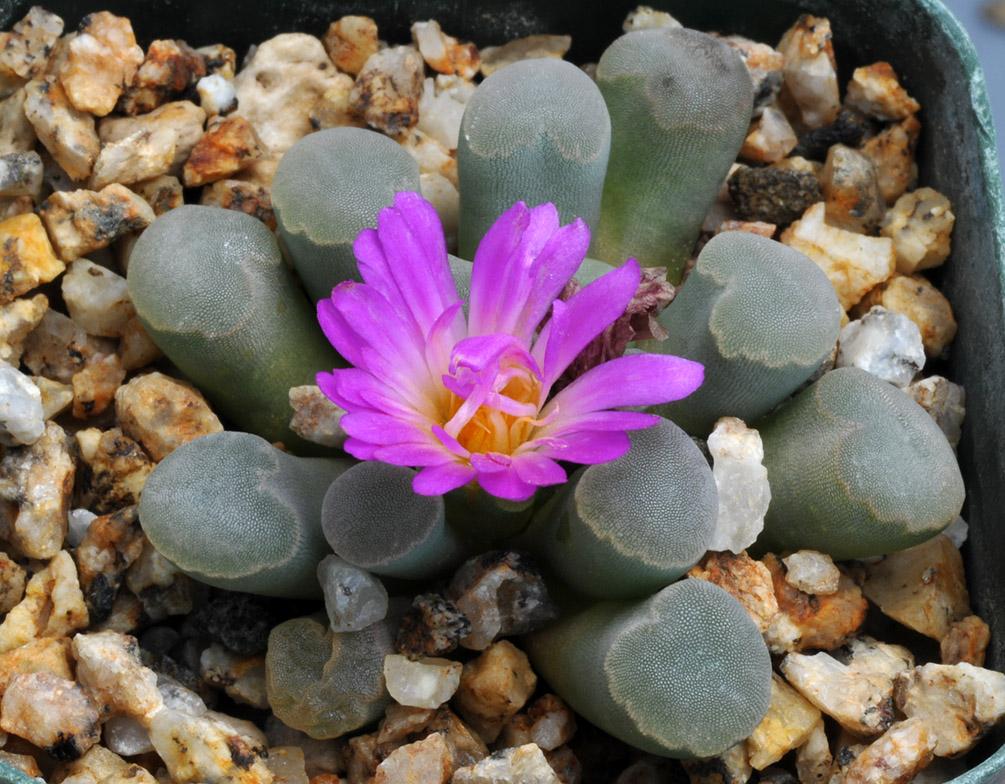
Common Names
Window Plants, Baby Toes, Fairy Elephant’s Feet, Transvaal Fairy Elephant’s Feet
Scientific Classification
Family: Aizoaceae
Subfamily: Ruschioideae
Tribe: Ruschieae
Genus: Frithia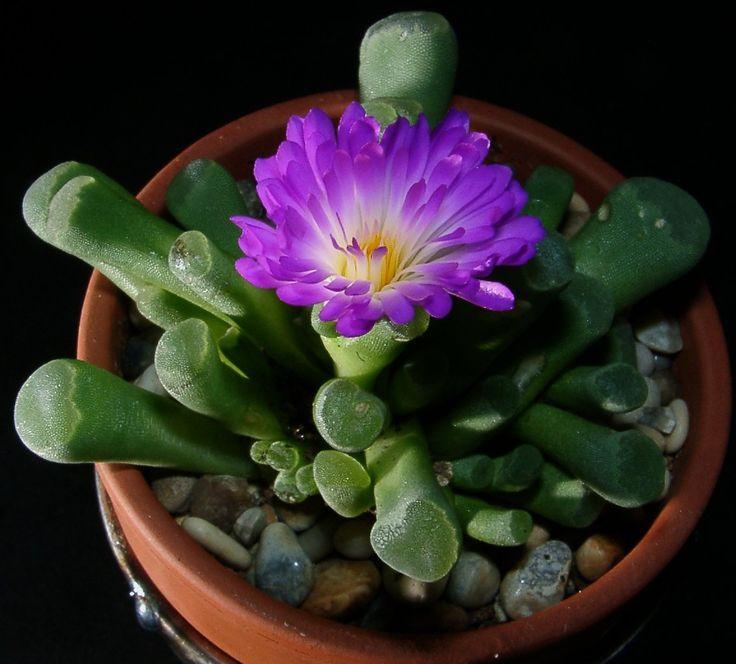
Description
Frithia pulchra is a dwarf rosette forming perennial succulent up to 1.2 inches (3 cm) in diameter, that grows almost completely embedded in the ground. Almost stemless or with a much reduced stem. Similar looking to the Fenestraria rhopalophylla, but its leaves are more tubular and the flowers are pink. Club shaped leaves, up to 0.8 inch (2 cm) long and up to 0.2 inch (5 mm) in diameter, often partially buried, grey-green, arranged in a cluster, flattened or rounded and transparent at the tips. Quite robust fruits, spongy capsules resembling a barrel, up to 0.2 inch (5 mm) in diameter and 0.25 inch (7 mm) long.
Hardiness
USDA hardiness zone 9b to 11b: from 25 °F (−3.9 °C) to 50 °F (+10 °C).
How to Grow and Care
Frithia is a summer grower and relatively easy to cultivate. It need light sporadic watering during its winter resting period and requires moderate sprinkling in summer as it is rot prone if kept too moist when the heat turns off its growth cycle. Gritty, well drained soil, containing a small amount of organic material will keep this species happy.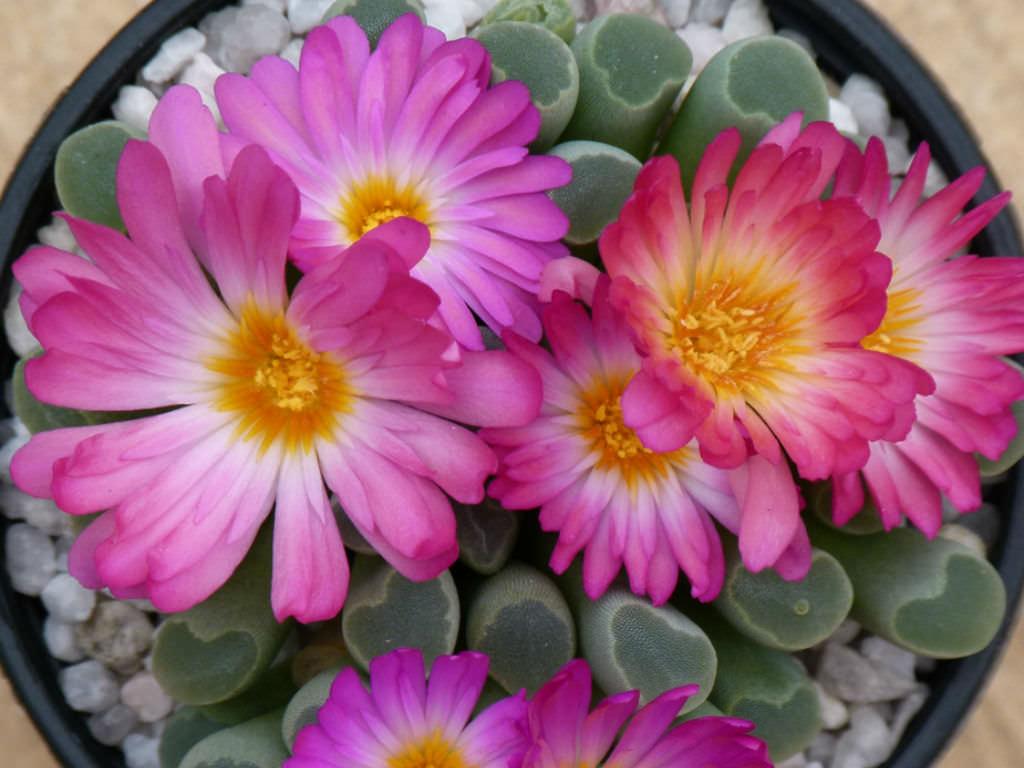
Frithia can be grown in pots or out of doors in a rockery. Soak the compost fully but allow it to dry out perfectly between waterings. Under-watering can lead to disastrous results, so be generous with water in summer. Nearly all problems occur as a result of overwatering and poor ventilation, especially when weather conditions are dull and cool or very humid.
Frithia pulchra N.E.Br.

Common Names
Window Plants, Baby Toes, Fairy Elephant’s Feet, Transvaal Fairy Elephant’s Feet
Scientific Classification
Family: Aizoaceae
Subfamily: Ruschioideae
Tribe: Ruschieae
Genus: Frithia

Description
Frithia pulchra is a dwarf rosette forming perennial succulent up to 1.2 inches (3 cm) in diameter, that grows almost completely embedded in the ground. Almost stemless or with a much reduced stem. Similar looking to the Fenestraria rhopalophylla, but its leaves are more tubular and the flowers are pink. Club shaped leaves, up to 0.8 inch (2 cm) long and up to 0.2 inch (5 mm) in diameter, often partially buried, grey-green, arranged in a cluster, flattened or rounded and transparent at the tips. Quite robust fruits, spongy capsules resembling a barrel, up to 0.2 inch (5 mm) in diameter and 0.25 inch (7 mm) long.

Hardiness
USDA hardiness zone 9b to 11b: from 25 °F (−3.9 °C) to 50 °F (+10 °C).
How to Grow and Care
Frithia is a summer grower and relatively easy to cultivate. It need light sporadic watering during its winter resting period and requires moderate sprinkling in summer as it is rot prone if kept too moist when the heat turns off its growth cycle. Gritty, well drained soil, containing a small amount of organic material will keep this species happy.

Frithia can be grown in pots or out of doors in a rockery. Soak the compost fully but allow it to dry out perfectly between waterings. Under-watering can lead to disastrous results, so be generous with water in summer. Nearly all problems occur as a result of overwatering and poor ventilation, especially when weather conditions are dull and cool or very humid.
0
0



